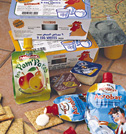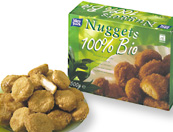
"It is clear we are entering a new food era, as the SIAL 2000 offering confirms," reported Cecile Bassot, managing director of SIAL. "Although less lavish than in the past, it is perhaps more consistent.
"The most striking characteristic is the extreme sophistication of the new products on display, from the manufacturing process to the choice of ingredients, packaging and even the positioning<\m>particularly audiences or eating times."
More than 5,000 exhibitors from about 90 countries attended SIAL 2000, which was held October 22-26 in Paris. Since its inception 36 years ago, SIAL has become the venue where food manufacturers showcase their most recent product innovations. This year, about 600 products were shown for the first time.
Sophisticated nutrition appears to be replacing the functional food fad. The general emphasis on health benefits has given way to a more sharpened focus on the natural beneficial attributes of a product, as opposed to the addition of magical ingredients.
For example, Sunjuice Ltd. from the U.K. exhibited its Bio Smoothie, which is from bio yogurt (contains probiotic culture) and various fruit purees. The company says it was very challenging to make the cranberry/raspberry flavor palatable, but was determined to use cranberry, which it believes will become very popular in the next few years due to its anti-carcinogenic properties.

However, there still were products touting their magical additives, such as the Love Drink containing ginseng and guarana from Liechtenstein's Smart Drinks Ltd. The company uses the terms "aphrodisiac, erotic, exotic, sexy and stimulation" in its advertisement of the drink. Energy Gum from Austria's Josef Ellersdorfer contains caffeine, vitamins and the amino acid taurine. It is said to taste like an energy drink.
In addition to foods and drinks with a health halo, SIAL 2000 has its share of truly unique products. For example, France's Les 3 Gourmands showcased ready-to-eat poached eggs. Two pre-cooked eggs resting in a variety of seasoned fluid bases are packed in microwavable tubs.
Canada's Produits Ronald Inc. introduced canned and marinated corn-on-the-cob that simply requires warming before eating. Varieties include Balsamic, Mediterranean, Teriyaki and Tex-Mex.

Natural, Indulgent & Convenient
Three overall product trends were very apparent to the more than 125,000 attendees. The first was the usage frequency of the terms "bio" and "organic" on the label, as well as the presence of the "AB Agriculture Biologique" logo, which is used throughout Europe's natural foods' sectors. Even Walkers Shortbread Ltd., Scotland, now offers organic versions of its famous pure butter cookies.Similar to what's happening here in the States, the second trend was the infrequency of the terms "nonfat" and "no calorie." This indulgence trend was exemplified in a new chocolate cream-filled breakfast cereal from Germany's Wurzener Nahrungsmittel, and in France's Fauchon new biscuit, a savory puff-pastry filled with Gouda cheese and herbs.
The final trend was the increase in convenience and single-serve food items. Denmark's Danaeg Products A./S introduced a range of liquid organic eggs packaged in small containers. Three varieties are available: whole egg, all white and all yellow. They come in either a fresh version, which has a refrigerated shelf life of 56 days, or frozen.
Many products rely on packaging to deliver convenience to the consumer. For example, Italy's Dalter Alimentari Spa claims to be the first to offer consumers a freshly grated cheese in portion-control cups. Spain's J. Garcia Carrion has put its Sangria in 330 ml Tetra Prisma aseptic cartons. It already offers many of its wines and fruits drinks in 200 ml aseptic bricks.
Two French companies are using a similar squeeze container for entirely different products<\m>but both are for kids. Materne is putting fruit purees in a squeezable package, while President fills it with an extra-creamy process cheese made with 50% milk and 49% cream. This item, named Acrobat', is said to be ideal for lunch boxes because, even though it requires refrigeration, it is alright to consume for up to 12 hours at room temperature.
Another industry trend seen at SIAL 2000 was the emergence of companies involved in business-to-business e-commerce and the Internet.
Global Product Trends
According to exhibition coordinators, most of the recently introduced foods appeal to one or more of the following consumer focuses. In parenthesis is a weighting factor (by percentage), which represents the number of new food products marketed across the world in 1999 that fit this focus. The data are derived from SIAL 2000/XTC Market & Product Intelligence.Active Health (7%)
These are foods that make health promises like "strengthens bones and helps fight cardiovascular disease." Market segments most affected are confectionery, dairy, dietetics and non-alcoholic drinks.
Citizenship (0.5%)
This is the requirement for an assurance of the manufacturer's good conduct in society, i.e., a portion of profits goes to a charitable fund. It's an opportunity for all market segments.
Cosmopolitan (6%)
This is the pleasure of exotic discovery, unknown tastes and new sensations. Market segments most affected are catering (foodservice), condiments, ready-cooked meals and sauces.
Easy to Handle (14%)
Consumers want foods to be convenient in all phases of existence: transport from point-of-sale to home, storage, preparation, use and finally, disposal. The idea is greater ease of use in order to provide maximum eating pleasure. This concept crosses all food categories; however, we are seeing the most activity in foods suitable for the tiny hands of kids, as well as foods specifically for seniors.
Ecology (0.5%)
This deals with consumers' desire to preserve the environment, and their desire to see food manufacturers do the same. It applies to all sectors.
Functionality (14%)
This is the ability to control one's body, appearance and vitality through food. Consumers are more educated today and they want functional information on foods. Market segments most affected by this aspect are biscuits, cakes, confectionery, dietetics and non-alcoholic drinks.
Safety (15%)
Eating must be a pleasant experience. All the food scandals of recent years have consumers questioning safety. They are now looking for assurances, such as knowing if a food is organically produced or GMO-free. The latter is the reason why soy-formulated foods are not very popular in Europe and were notably absent at SIAL. This reassurance is most wanted in catering, dairy and ready-cooked meals.
Sensation Variety (27%)
Consumers want variety: different shapes, creative colors, unique textures, flavors and tastes, etc. In this respect, seasonal products are doing very well because it provides a point of difference. This concept crosses all food categories.
Solution Products (7%)
Consumers continue to look for foods that help them prepare good meals, quickly. They want timesaving meal and snacking solutions. This concept applies to all foods, but is most apparent in catering and sweet and savory snacks.
Sophistication (5%)
Eating provides pleasure, and is often obtained through seeking difference. Consumers are looking for premium, value-added products that often contain select ingredients and are made through unique processes. This applies mostly to catering, cheese and ready-cooked meals.
Traditional (4%)
As much as consumers are looking for unique foods, they also want to be able to fall back on their roots, but in a specialty sense. They are looking for gourmet traditional foods. Market segments most affected are catering, cheese and ready-cooked meals.
The convenience trend ran the gamut from liquid organic eggs packaged in small containers and mini cups of grated Italian cheese to squeeze packs of single-serve fruit purees and extra-creamy process cheese.